
Shown are the right and left sides of the Ames Bown rifle.
This past March, I was working for my friend, Kirby Hoyt, who runs the gun shop known as “Vintage Doubles.” Kirby sells classic side-by-side shotguns, some of which were specifically proofed in the 1800s for black powder. He had me reseal the shop floor, which entailed moving his accumulation of stuff from one part of the floor to another, then back again. During this resealing job, a crusty, dusty percussion rifle came out from the stairwell into the light of day for the first time in who knows how long.
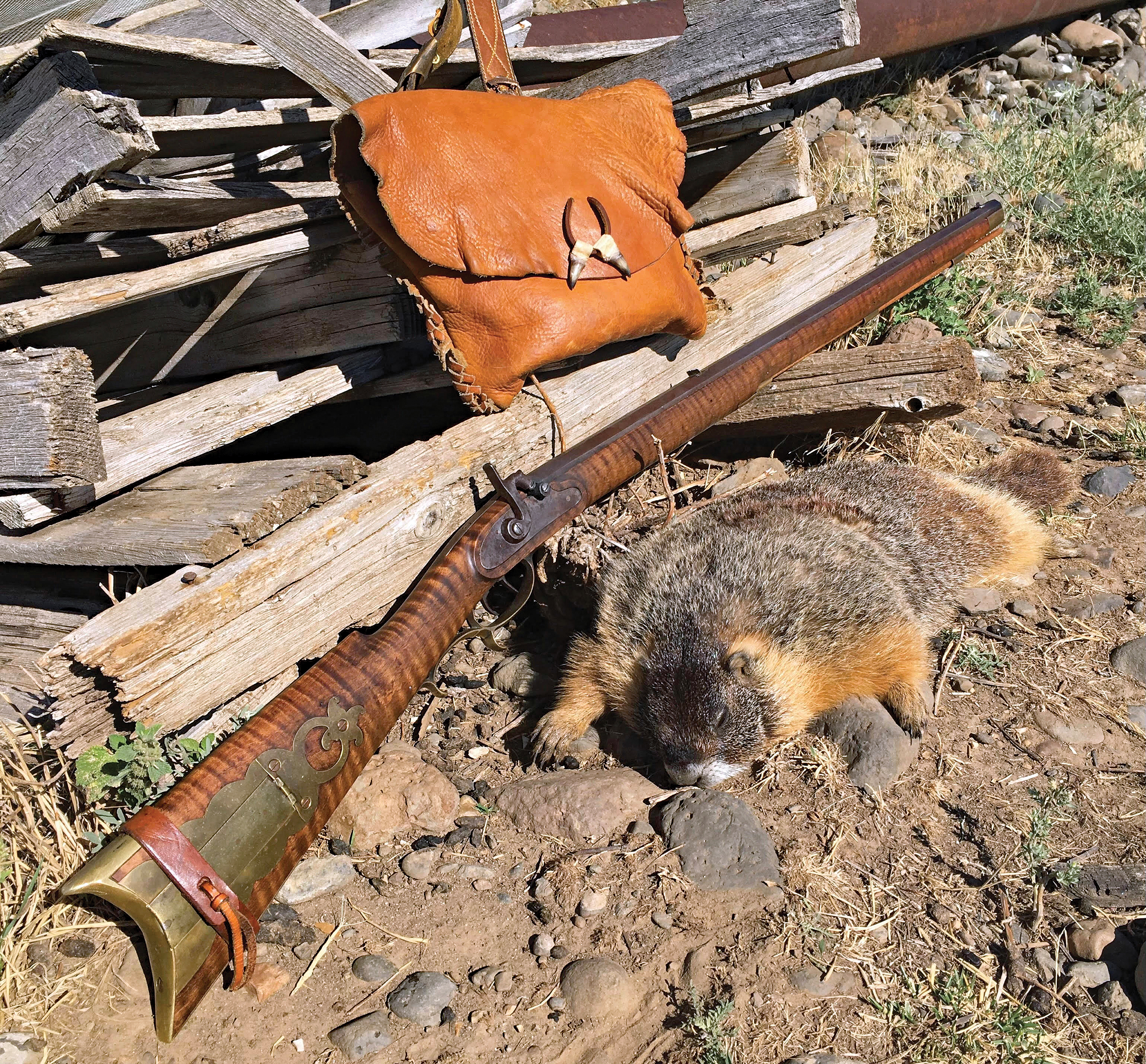
The .30 Ames Bown & Son muzzleloader and proof of the hunt.
The first thing I noticed about the gun was its lightness. It was clearly a trim rifle. I was equally pleased to see from the muzzle that it had a small bore, no bigger than .30 caliber. I’ve hunted with my .54 Hawken but have always fantasized about hunting small game with a smallbore black-powder rifle. Who hasn’t been Daniel Boone or Davey Crockett in their hearts when carrying a weapon and chasing game? Summers in Indiana as a six-year-old found me stalking the grey squirrels on my grandparents’ property with an adult size bow and mismatched arrows. The squirrels never took me seriously and a few of my granddad’s arrows were left to decorate the willows. Yes, those were good old days.
After dusting off the relic, I was a bit stunned to see the quality of the stock. Beautiful tiger maple that I held in my hands, a full-length stock with slim dimensions well suited to the bore size. Curiosity led me to look for any markings on the barrel. There was a very faint name on the left barrel flat forward of the breech that read, “AMES BOWN & SON.” This was extraordinary to me because my name happens to be James Bowen. When I got home, I investigated old Ames and was shocked to discover his name was actually James. The “J” is worn off or was never properly impressed into the steel.
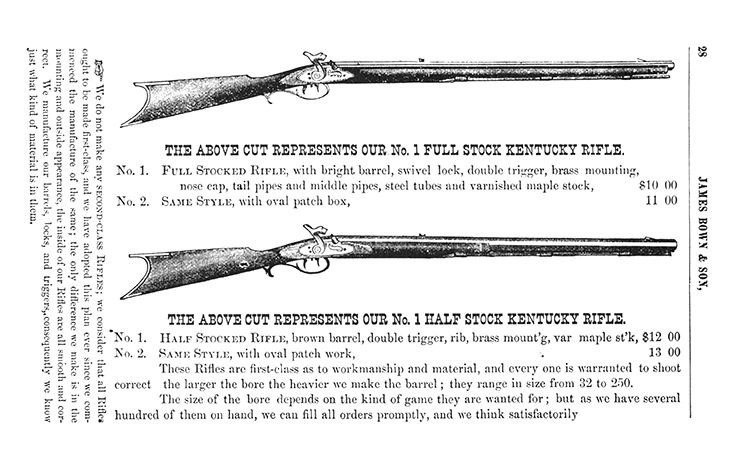
From 10 Old Gun Catalogs by Satterlee.
I have a copy of the book entitled,
The Plains Rifle, by Charles Hanson, Jr. In it, he refers to James Bown on pages 58, 73 and 78. Bown manufactured rifles and cutlery in Pittsburg under the company name of “The Enterprise Gun Works” between 1848 and 1862. Later, the firm became James Bown & Son. He passed away in January 1901. Now, I needed to see if I could buy this little Bown rifle! When I inquired, Kirby said he didn’t remember the rifle or where it had come from. He offered it to me at a price I couldn’t refuse, whether the gun would ever safely shoot again or not. Being very knowledgeable about vintage guns, he recommended changing the nipple, which appeared to be as old as the rifle itself.
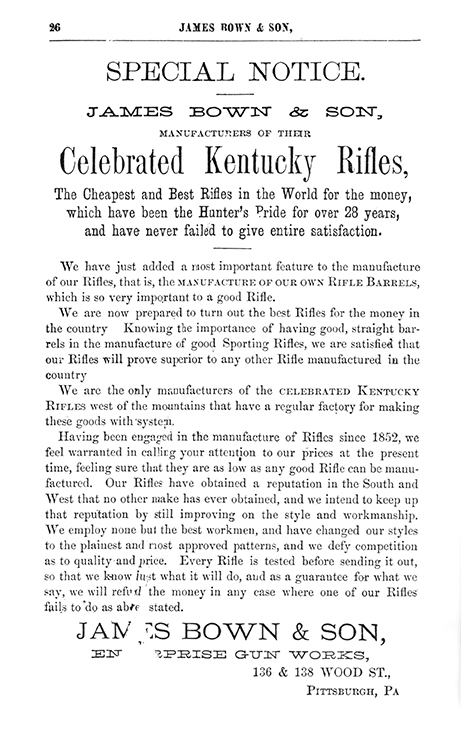
From 10 Old Gun Catalogs by Satterlee.
A gunsmith friend ran a borescope down the barrel and gave two observations: it was safe to shoot and the rifling was pretty well worn out. Updating the nipple required retapping the powder drum to modern thread size and reshaping the nipple itself to mate properly with the hammer face. It was then on to find modern percussion caps that would both fit and fire reliably. If you have attempted to buy percussion caps in the last year, you might know what a challenge this was. Thanks to friends, I got hold of a few different tins over the period of couple months. At last, I determined that the RWS 1075 cap worked satisfactorily.
I must admit I was more than slightly nervous to actually fire the rifle, but that was the next logical step if it was to hunt again. After reading some related information, I decided on a trial load of 15 grains of FFg, a .015 patch and a .310 roundball that I hand-ground to fit. Grinding down a roundball is a real pain! The tips of my thumb and first finger were sore for days. I used a “Lead Sled” as a cradle and the ramrod to lever back the trigger while I crouched beside the bed of my truck. Much to my relief, the rifle gave a healthy “pow” and held together! I think it’s remarkable for a 160-year-old gun. It’s fun to wonder when the last time was it was shot.
After proving the rifle does have life left in it, came the efforts to find a reasonably accurate load. I hoped to be able to reliably hit a clay pigeon sitting on edge at 40 yards. From the start, the results were disheartening. I had already slugged the bore and had an average measurement of .305. Then, I had a lot of frustration looking for an appropriate caliber ball. I ended up turning to buckshot of roughly the right size. Nothing produced consistent groups under 2.5 inches at 25 yards, not good enough for grey squirrels or bunnies. Part of the problem might have had to do with my 60-year-old eyes. The front sight was a tiny blur. An old friend of mine let me paw through his box of front sights and take two to try. A sight from a “Little Favorite” fit with a small amount of filing. But the groups didn’t improve significantly.

Top flat of barrel showing the makers signature.
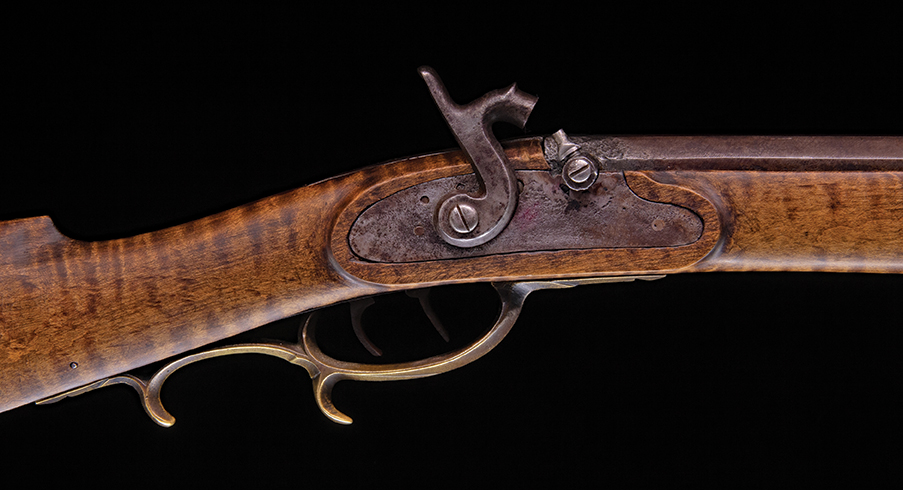
The lock area of the Bown rifle.
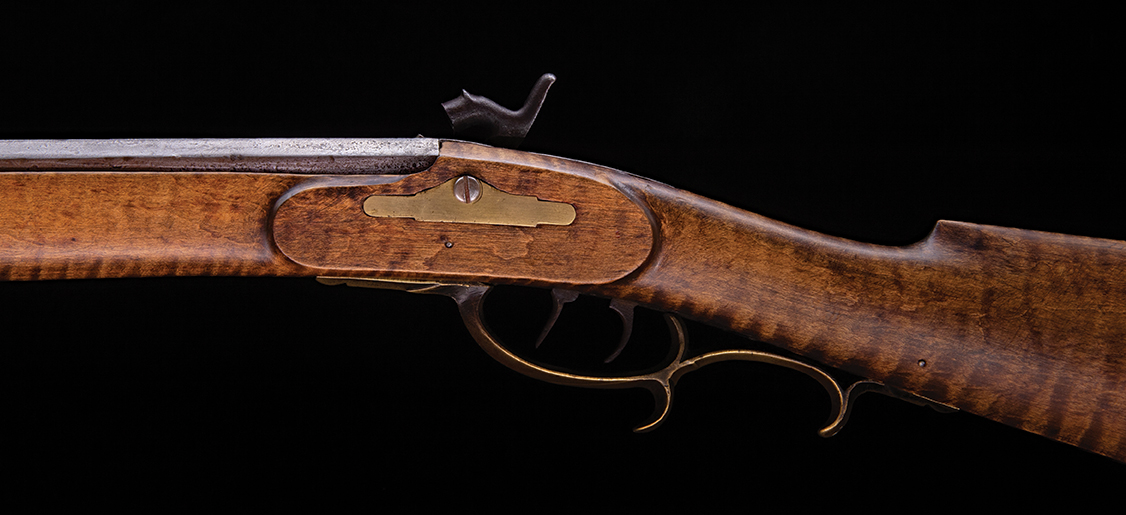
The lock area of the Bown rifle.
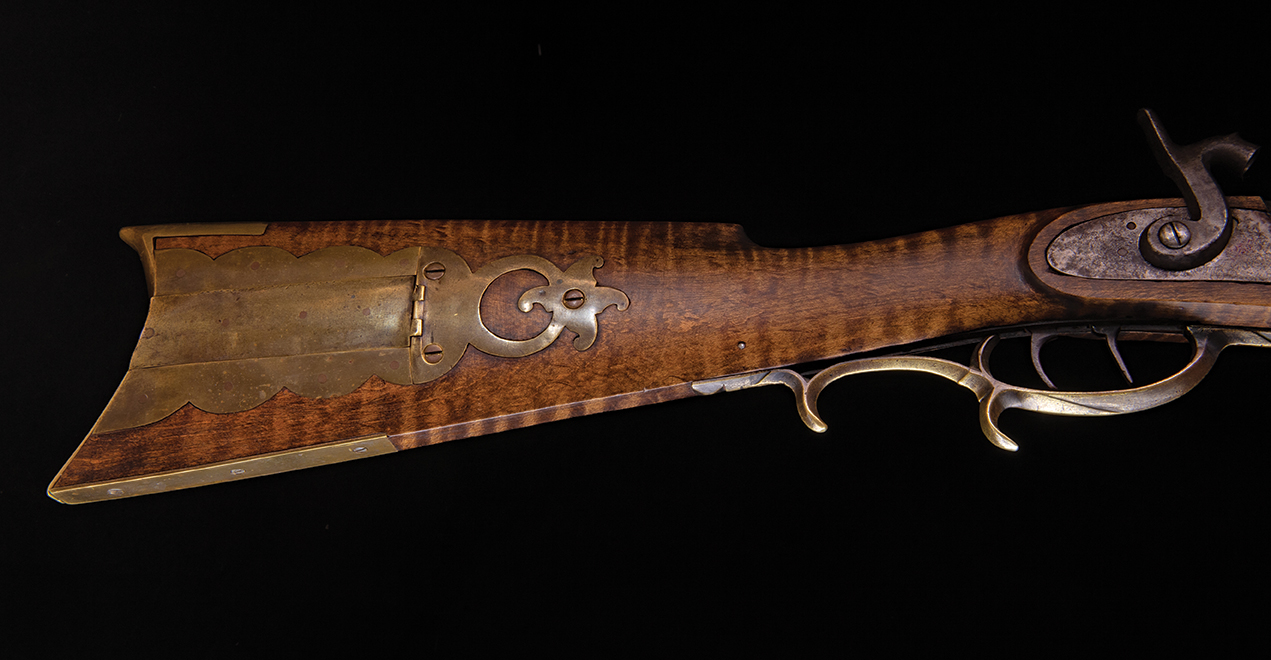
Patchbox of the Bown rifle.
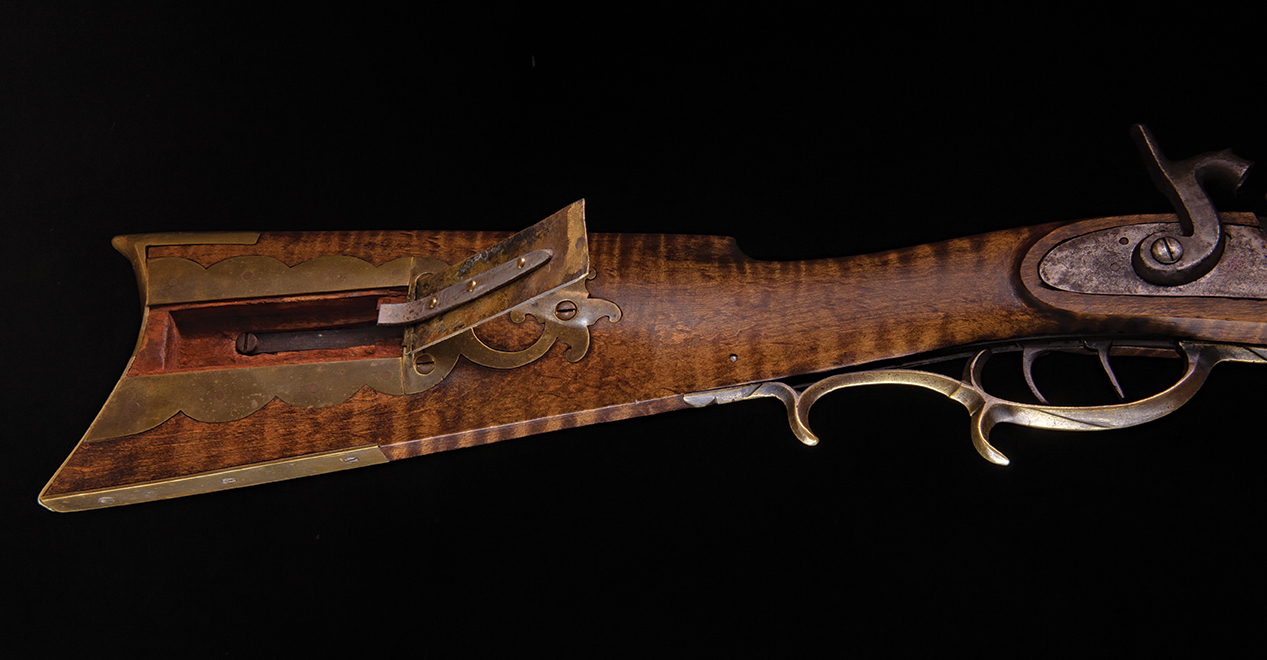
Patchbox of the Bown rifle.
In a previous issue of
The Black Powder Cartridge News, I came across an ad for The High Plains Reboring & Barrels, LLC, Norman Johnson owner. Johnson agreed to rebore the rifle and recut the rifling. I was very surprised to have the barrel back in my hands within two weeks! It is now a .330 bore and able to shoot .310 roundballs. On the first shot at the range I thought I might have missed the paper at 25 yards. I couldn’t see a hole until I walked up to the target. There was a dead “bullseye,” in fact, the next four shots all hit the 2-inch bullseye! Thank you, Mr. Johnson! The Bown shows a preference for 20 grains of FFFg and two .010 patches with the .310 roundball.
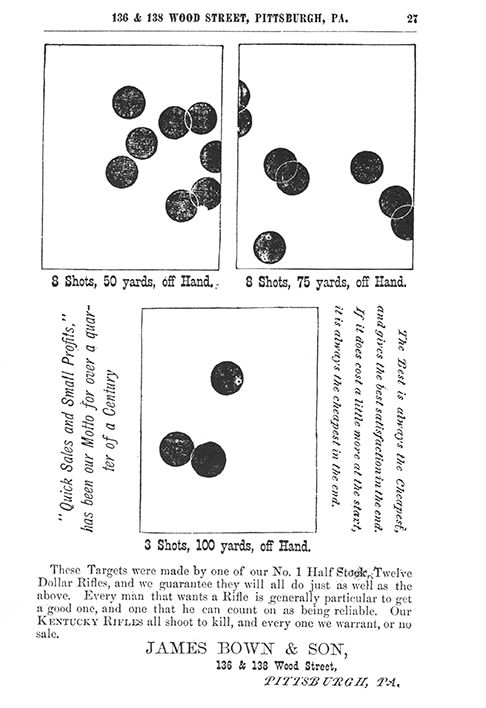
From 10 Old Gun Catalogs by Satterlee.
By now, it was May and I turned my attention to that fantasy of taking a squirrel with a black-powder rifle. On a bright morning, I snuck into the brush along the side of a rocky gully in which I’ve shot rockchucks with centerfire rifles over the years. Within minutes of getting settled on my shooting sticks, a fat chuck climbed up onto a rock about 30 yards out. The shot was virtually instinctive and yet again, I was surprised when the big chuck just slumped down dead. The photo included captured the culminating fruits of several months’ work and learning. This James Bowen is very impressed with the workmanship of the James Bown, who built this handy little rifle 160 years ago. Now onto more chucks, bunnies and maybe even that elusive grey squirrel!













